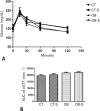Sericin as treatment of obesity: morphophysiological effects in obese mice fed with high-fat diet
- PMID: 31576909
- PMCID: PMC6905161
- DOI: 10.31744/einstein_journal/2020AO4876
Sericin as treatment of obesity: morphophysiological effects in obese mice fed with high-fat diet
Abstract
Objective: To investigate the effects of sericin extracted from silkworm Bombyx mori cocoon on morphophysiological parameters in mice with obesity induced by high-fat diet.
Methods: Male C57Bl6 mice aged 9 weeks were allocated to one of two groups - Control and Obese, and fed a standard or high-fat diet for 10 weeks, respectively. Mice were then further subdivided into four groups with seven mice each, as follows: Control, Control-Sericin, Obese, and Obese-Sericin. The standard or high fat diet was given for 4 more weeks; sericin (1,000mg/kg body weight) was given orally to mice in the Control-Sericin and Obese-Sericin Groups during this period. Weight gain, food intake, fecal weight, fecal lipid content, gut motility and glucose tolerance were monitored. At the end of experimental period, plasma was collected for biochemical analysis. Samples of white adipose tissue, liver and jejunum were collected and processed for light microscopy analysis; liver fragments were used for lipid content determination.
Results: Obese mice experienced significantly greater weight gain and fat accumulation and had higher total cholesterol and glucose levels compared to controls. Retroperitoneal and periepididymal adipocyte hypertrophy, development of hepatic steatosis, increased cholesterol and triglyceride levels and morphometric changes in the jejunal wall were observed.
Conclusion: Physiological changes induced by obesity were not fully reverted by sericin; however, sericin treatment restored jejunal morphometry and increased lipid excretion in feces in obese mice, suggesting potential anti-obesity effects.
Objetivo: Investigar os efeitos da sericina extraída de casulos de Bombyx mori na morfofisiologia de camundongos com obesidade induzida por dieta hiperlipídica.
Métodos: Camundongos machos C57Bl6, com 9 semanas de idade, foram distribuídos em Grupos Controle e Obeso, que receberam ração padrão para roedores ou dieta hiperlipídica por 10 semanas, respectivamente. Posteriormente, os animais foram redistribuídos em quatro grupos, com sete animais cada: Controle, Controle-Sericina, Obeso e Obeso-Sericina. Os animais permaneceram recebendo ração padrão ou hiperlipídica por 4 semanas, período no qual a sericina foi administrada oralmente na dose de 1.000mg/kg de massa corporal aos Grupos Controle-Sericina e Obeso-Sericina. Parâmetros fisiológicos, como ganho de peso, consumo alimentar, peso das fezes em análise de lipídios fecais, motilidade intestinal e tolerância à glicose foram monitorados. Ao término do experimento, o plasma foi coletado para dosagens bioquímicas e fragmentos de tecido adiposo branco; fígado e jejuno foram processados para análises histológicas, e amostras hepáticas foram usadas para determinação lipídica.
Resultados: Camundongos obesos apresentaram ganho de peso e acúmulo de gordura significativamente maior que os controles, aumento do colesterol total e glicemia. Houve hipertrofia dos adipócitos retroperitoneais e periepididimais, instalação de esteatose e aumento do colesterol e triglicerídeos hepáticos, bem como alteração morfométrica da parede jejunal.
Conclusão: O tratamento com sericina não reverteu todas as alterações fisiológicas promovidas pela obesidade, mas restaurou a morfometria jejunal e aumentou a quantidade de lipídios eliminados nas fezes dos camundongos obesos, apresentando-se como potencial tratamento para a obesidade.
Conflict of interest statement
Conflict of interest: none.
Figures










References
-
- 2. de Wit NJ, Bosch-Vermeulen H, de Groot PJ, Hooiveld GJ, Bromhaar MM, Müller M, et al. The role of the small intestine in the development of dietary fat-induced obesity and insulin resistance in C57BL/6J mice. BCM Med Genomics. 2008;1:14. - PMC - PubMed
- Wit NJ, Bosch-Vermeulen H, Groot PJ, Hooiveld GJ, Bromhaar MM, Müller M, et al. The role of the small intestine in the development of dietary fat-induced obesity and insulin resistance in C57BL/6J mice. 14BCM Med Genomics. 2008;1 - PMC - PubMed
-
- 3. Scoaris CR, Rizo GV, Roldi LP, de Moraes SM, de Proença AR, Peralta RM, et al. Effects of cafeteria diet on the jejunum in sedentary and physically trained rats. Nutrition. 2010;26(3):312-20. - PubMed
- Scoaris CR, Rizo GV, Roldi LP, Moraes SM, Proença AR, Peralta RM, et al. Effects of cafeteria diet on the jejunum in sedentary and physically trained rats. Nutrition. 2010;26(3):312–320. - PubMed
-
- 4. Clara R, Schumacher M, Ramachandran D, Fedele S, Krieger JP, Langhans W, et al. Metabolic adaptation of the small intestine to short- and medium-term high-fat diet exposure. J Cell Physiol. 2017;232(1):167-75. - PubMed
- Clara R, Schumacher M, Ramachandran D, Fedele S, Krieger JP, Langhans W, et al. Metabolic adaptation of the small intestine to short- and medium-term high-fat diet exposure. J Cell Physiol. 2017;232(1):167–175. - PubMed
-
- 5. Mao J, Hu X, Xiao Y, Yang C, Ding Y, Hou N, et al. Overnutrition stimulates intestinal epithelium proliferation through β-catenin signaling in obese mice. Diabetes. 2013;62(11):3736-46. - PMC - PubMed
- Mao J, Hu X, Xiao Y, Yang C, Ding Y, Hou N, et al. Overnutrition stimulates intestinal epithelium proliferation through β-catenin signaling in obese mice. Diabetes. 2013;62(11):3736–3746. - PMC - PubMed
Publication types
MeSH terms
Substances
LinkOut - more resources
Full Text Sources
Medical

